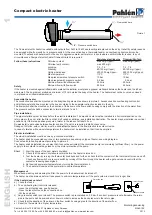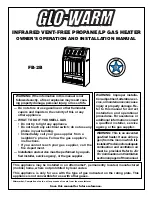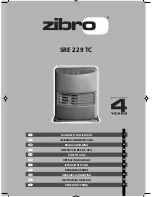
APR 2018
22
Hot Water Energy Storage
Unvented Cylinders
GB & NI
Installation & Maintenance Instructions for an unvented
hot water cylinder with external thermal expansion
STERILISATION
Only switch on power to the immersion heaters once
sterilisation liquid has been purged and the cylinder filled with
water.
FLUSHING & FILLING THE CYLINDER
Check that the pressure in the expansion vessel is 3 bar
(45PSI), i.e. the same as the setting of the pressure reducing
valve. The valve is of the car tyre (Schrader) type. Check
all the connections for tightness including any factory
made connections such as the immersion heater and the
temperature and pressure relief valve. Before filling, open the
hot tap furthest away from the unvented cylinder to let air
out.
Open the cold main isolation valve and allow the unit to fill.
When water flows from the tap allow it to run for a short while
to flush through any dirt, swarf or flux residue. Close the tap
and open every other hot tap in turn to purge all remaining air.
DIRECT UNITS
Allow the unit to start to heat, the immersion heater is
supplied preset at 55ºC. Turning fully to ‘+’ set to approx
65ºC. Allow unit to heat up, adjust the thermostat so that
the heater switches off at 60ºC. Record information on the
Benchmark Commissioning Checklist (Page 25).
INDIRECT UNITS
Ensure the heating circuit has been fully flushed, carrying
out commissioning in line with the boiler or heat pump
manufacturer’s commissioning instructions for the
heating and the primary circuit. Primary pipework must
be filled, vented and tested in accordance with the boiler
manufacturer’s instructions. To ensuring all pipework is fully
vented, bleed valves may need opening, especially on any
raised pipes; inadequate flushing or venting could cause
damage to the circulation pump.
Ensure the lever on the two port valve is set to the filling
position and fill the primary circuit; ensuring the appropriate
inhibitors are added in the right concentrations. When full,
move the lever back. Switch the programmer to Domestic
Hot Water (DHW) and allow the unit to start to heat. Adjust
the dial of the dual thermostat to between 55°C and 65°C as
required. Allow unit to heat up, adjust the thermostat so that
the heater switches off at 60°C. Record information on the
Benchmark Commissioning Checklist (Page 25).
STORAGE TEMPERATURE
The recommended storage temperature for both direct and
indirect cylinders is 60-65°C. In hard water areas consideration
should be given to reducing this to 50-55°C. In many
healthcare applications the guidance on Legionella control
and safe water delivery temperatures will require storing
the water at 60-65°C, distributing at 50-55°C and using
thermostatic mixing valves to control the final temperature.
For details consult the NHS Estates Guidance on safe hot
water temperatures.
SAFETY CHECKS
During heat-up double check all pipework for leaks, ensuring
all connections including the immersion heaters and any
pre-plumbed connections are water tight. There should have
been no sign of water coming from either the expansion
relief valve or the temperature/pressure relief valve. Now
hold both of these safety valves fully open, allowing as much
water as possible to flow through the tundish. Check that
your discharge pipework is free from debris and is carrying
the water away to waste efficiently. It is normal that some
water will splash out of the tundish. This should be minimised
by ensuring the tundish, D1 and D2 pipes are vertical to
allow clean flow. Release the valves and check that they
reseat properly. On completion of commissioning, fill in
the Benchmark Commissioning Checklist & leave with the
homeowner.
BENCHMARK SCHEME
The installer must follow the Benchmark code of practice for
the Benchmark certification to be valid. The Benchmark code
of practice can be found online via www.centralheating.co.uk
DECOMMISSIONING & DISPOSAL
Damage to the environment and risks to personal health are
avoided by the proper decommissioning and disposal of this
product.
To decommission your unvented hot water cylinder,
isolate the electricity supply to the immersion heater and
boiler/heat pump, before draining the cylinder and safely
disconnecting all fixtures and fittings.
The cylinder is made from many recyclable materials;
therefore we strongly encourage recycling of this product
at your Local Authority recycling centre at the end of its
working life. For more information on proper disposal, please
contact your local council or waste disposal office.
COMMISSIONING







































